Aphrodisias and more | home
Some World Class Stuff
We drove west and then north from Cirali, leaving the Mediterranean coast for the first time. We passed through a coastal mountain range with scenery in places reminiscent of Evergreen, Colorado - towering long needled pines, rugged ridges and beautiful vistas. In the midst of this lies Arycanda, a ruin well off the beaten path, the subject of ongoing excavation. Arycanda is a hidden gem. Quiet, scenic and, like Termessos, harder to reach than many other ruins, a characteristic that has helped preserve some of the structures. Probably its most distinctive features are its Roman Baths, among the best in the world.
|
Here I am standing on the wall of one of the baths, looking in.
|
Arycanda also has a nice theater, below. Note the large tree growing out of the seats (that's me again sitting there).
|
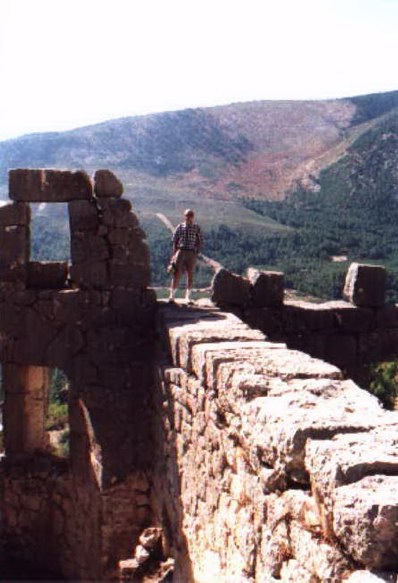 |
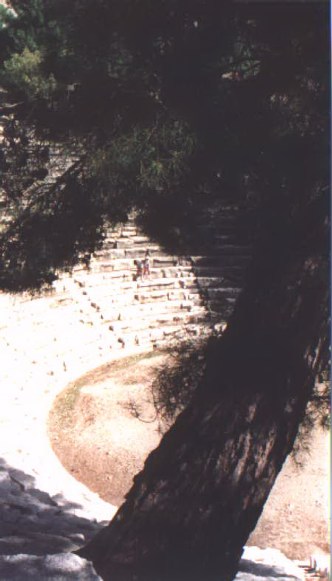 |
The access road into Arycanda looked like a rocky gravel driveway and was poorly marked. We drove by it a couple of times before accepting that this little jeep road was the way in. Keep in mind that we jockeyed an old Landcruiser all over the Colorado mountains for over 10 years, so we know a jeep road when we see one. When we pulled into the wide spot in the "road" that served as a parking lot, we were the only visitors (we were soon joined by a French couple). Nonetheless, we were greeted by the ubiquitous parking lot attendant who, ticket book in hand, collected a fee.
|
Before we move on to what was my favorite ruin, Aphrodisias, I want to digress and talk about carpet sellers. Turkish carpets are big business. There are carpet shops on every corner of every street of every town we were in. And each of these shops has a proprietor standing or sitting out front assessing the passersby. Of course, we were easily spotted for tourists, an obvious target for the salesmen. And so, from Antalya to Istanbul, and sometimes in our dreams, we heard the same refrain: "Hello! (this first was often shouted out in several languages as they tried to figure out your nationality) Can I interest you in some carpet? I would like to welcome you into my shop. May I get you some tea? Where are you from?" And so it went, time after time after time, usually with the salesman keeping pace chatting with us as we tried to walk on by. Everywhere we went we were near the end of the season, and since the tourist traffic was pretty thin, we received a lot of attention. Many salesmen also explained to us that it had been a bad year for their trade because of the terrorism in Eastern Turkey early in the year, and also because of the big earthquake. Of course, their loss was our potential gain, since they all claimed to be ready to give a huge discount, so badly did they need a sale. At any rate, it was nearly impossible to take a peaceful stroll down any street in a Turkish town. There were too many carpet sellers. We came to accept this reality and after a few days we no longer felt any guilt about telling them no thank you as we walked on by. The only part of this that we never really solved was that on some occasions we would have liked to stop and just window shop. There were some locations where this was possible, but most of the time it was not.
We eventually did some shopping in Turkey. Most of it involved lots of haggling. To a Turk, this haggling is part of the fabric of their life. They do not get wound up over it. Done properly, it is not confrontational. It is simply a part of their culture.
Susie hated these negotiations and eventually walked off while I made the deals. I enjoyed the process but was never under any illusions about getting any spectacular results. After all, for generations the shop keepers have been haggling. We were there for less than two weeks. Our goal was to pick up some gifts and a few keepsakes and not get clipped too badly in the process.
|
OK, on to Aphrodisias. After leaving Arycanda we drove on through inland Turkey and eventually reached our destination, Aphrodisias. The scenery was similar to the American west - arid, pretty scrubby. The people looked dirt poor. Here is a picture we took enroute of what we think are wagons full of sugar beets pulled up in front of a processing plant. We leaned out the window of the car to take this, having already passed perhaps a 1/4 mile long line of these wagons parked on the shoulder.
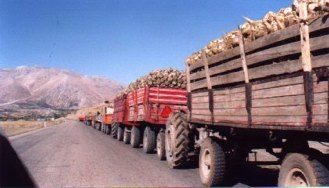
|
Aphrodisias is what you come to Turkey to see. It was an important city in its day, particularly noted for the quality of its marble stonework and sculpture. Everywhere we went in Turkey, we were staggered by the amount of carved and cut stone that was required to build these cities. Many of these places were built over the course of hundreds of years and it shows. When you stand in the midst of any one of these sites and consider the tools available and the means by which all this was transported and assembled some 2,000 years ago, and you look at the incredible precision and craftsmanship, well, you have to see it to believe it. And there is so much of it.
Most of the really fine sculpture is in museums. We visited several that are located at or near the ruins sites. However, a major bone of contention to the Turkish people is that for centuries many of the important artifacts have been taken from these places by foreign archeologists, and are now displayed in museums in Europe and elsewhere. Turkey would like to recover this stuff. Much of it was removed by the British and others before the modern Republic of Turkey even existed (1923). For example, the Vatican museums are loaded with some outstanding Roman era sculpture, some of which was "stolen" from Turkey.
Some of the sculpture is intact. Some of it has undergone such extensive reconstruction and renovation it is a wonder that they could identify the few original pieces as belonging with one another. In addition to the damage inflicted by nature, most of these cities and their treasures were repeatedly abused by various invading forces throughout history.
|
Here are some pictures of the ruins at Aphrodisias:
These first two are of a temple that is probably the ruin's poster child.
|
||
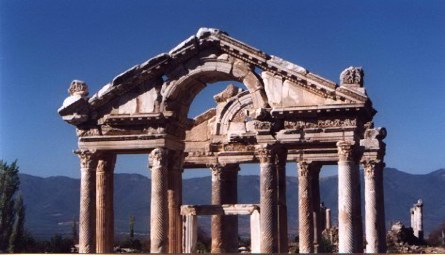 |
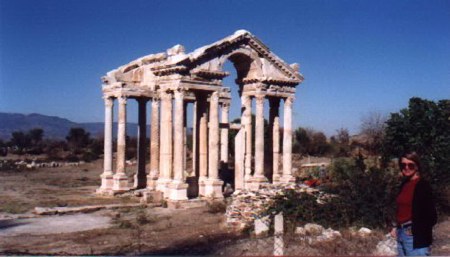 |
|
Here is the stadium, the best in the world. Most stadiums these days are open grassy areas, the stone long since removed for use in other structures. For some reason this one survived, and it is awesome. In typical Roman fashion, it is longer and narrower than our stadiums today, but it seats something like 40,000 people! On this beautiful day, it only needed to seat 2.
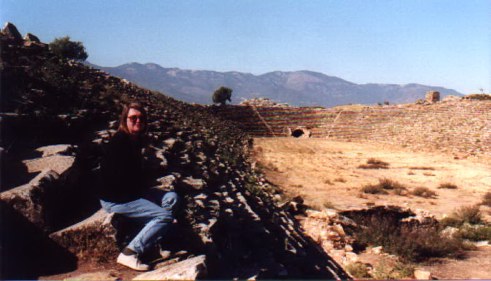 |
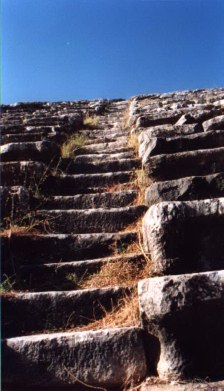 |
You can see, left, that like today's stadiums, there are stairs providing access to the seats. Note that at the end of the seating rows, the stone has been carved into legs with claw feet. This was done at the end of every row throughout the stadium. The seats themselves are not simple flat stone. They are slightly elevated, perhaps 1/2" or less, where you would sit, and behind, where the person behind you would place his feet, the surface was lower, presumably to provide for water drainage.
|
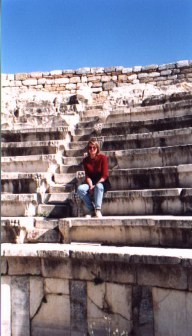 To the right: the Odeon or small theater. These were typically located near the center of town, where they served as meeting areas for city government, town hall meetings and entertainment venues. This one was exceptional in that the original marble facia is still in place throughout. The claw foot design characterizing the end of the seat rows is much better preserved in this structure.
|
The picture below is of some well preserved sarcophogi displayed outside of the museum.
|
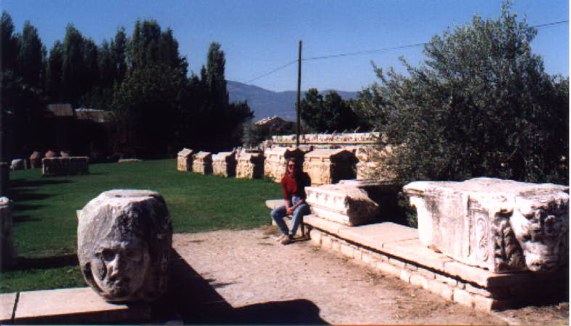 |
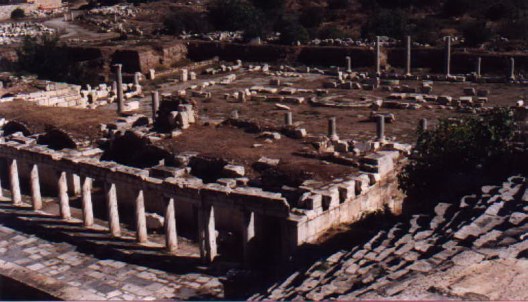 |
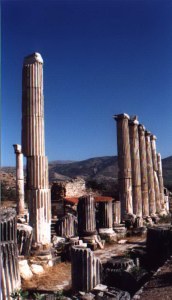 Here are a couple of pictures I took to try and show the scope of the place. There was a lot to see here! These were taken in different areas, several hundred yards apart.
|
We spent most of the morning at Aphrodisias, including a walk through the impressive museum there.
Our next stop was a two hour drive toward the western coast, the Aegean Sea, to see the ruin of the Temple of Apollo at Didyma. This is the ruin of an ancient, pre-roman pagan temple. For centuries it was the site of an Oracle where folks used to go for answers to important questions. You had to be careful with the Oracle. If he didn't like your style he would nail you with a lightning bolt or otherwise do you in. There is not a city at the site of this temple. The temple itself is the attraction and upon our arrival we quickly understood why. The scale of this place was double or triple that of any other building we saw. Check out in particular the diameter of the columns and you can appreciate its size.
|
There are many partial columns in place and it is easy to see where they once stood. Below right, column sections on edge.
|
|
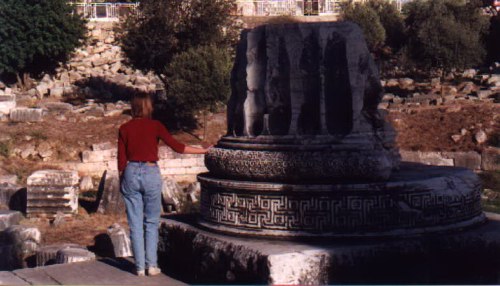 |
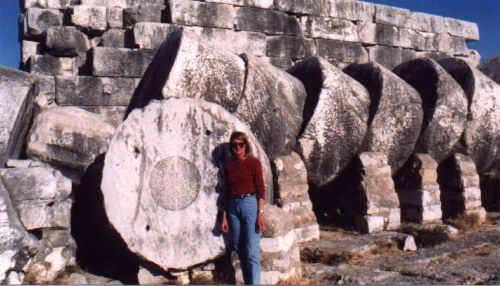 |
This Didyma Medusa head is understandably pretty famous
(that's Medusa on the right).
|
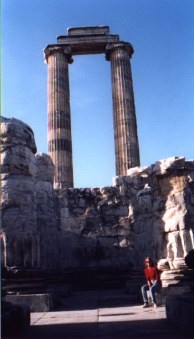 In its prime, this temple featured 122 of these huge standing columns. In its prime, this temple featured 122 of these huge standing columns. |
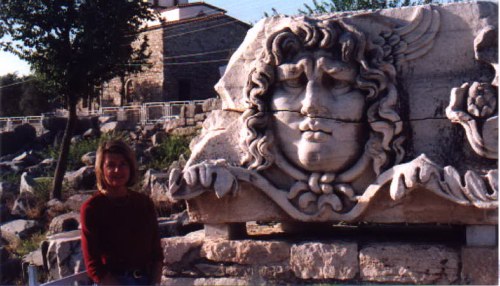 |
Next: to Selcuk and Ephesus.